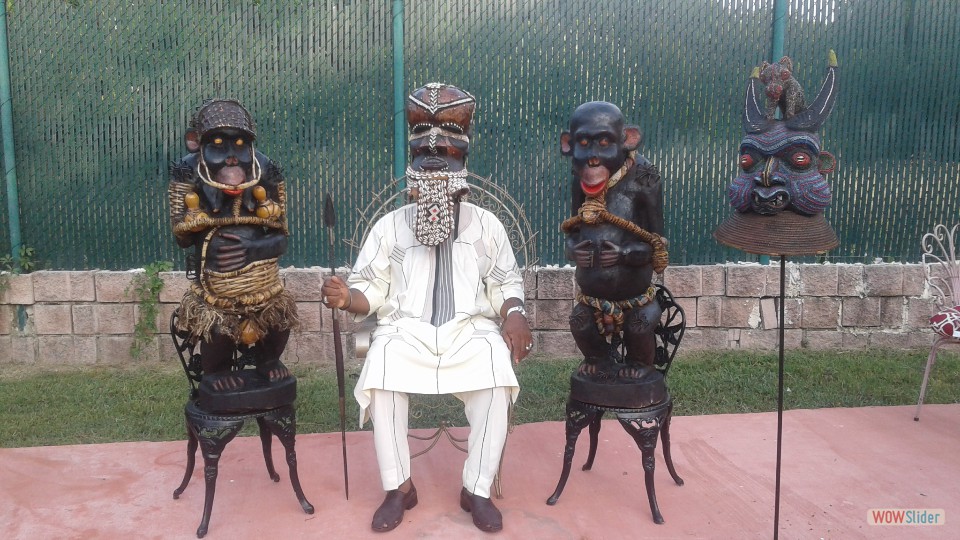African Exhibit and Folk Art
African Wood Carving: 19th – 20th century
In Africa, south of the Sahara, wood is the natural material for carving. In the 20th century sculpture in wood is still very much a living tradition. Tribal carving is done for clear and practical purpose. A figure may represent an ancestor, destined to stand in a shrine. A mask may be intended for use by a Shaman just once a year in a special dance. A post may be designed to prop up a chief’s verandah or to form part of a palisade round his house. An elaborate chair is likely to be for the chief himself to sit on. All of them will be better is carved in a dramatic or propitious way.
Signiant’s of African Wood Carving: 19th – 20th century
Today, Ghanaian wood carvers produce an endless variety of figurines and plaques for the tourist trade, or for export to other countries. Some are cleverly designed with modern African figures and animals. If you go back 100 years or more, however, you wouldn’t see such individual creativity. In the old days, carving was done as a communal, not individual, form of expression. Deviation from community accepted standards and designs was tabooed. Carving was done under the strict direction of clan leaders, and was totally done by men. Not every man carved. The carvers were seen as a privileged minority endowed with special skills from God. They even had their own secret initiation rituals for apprentices.The African exhibits proved a variety of educational topics that highlight the African American History and Africa Wood Carving and Sculpture’s unique history.
Please email to book your exhibit!
Type of events we service:
Please contact Roosevelt Nichols at nick0420@sbcglobal.net or 469-358-8722 to book your event.
Wood Carving Schools with Program Overviews African
Woodcarving is the art of shaping wood pieces to define, pre-determined structure, such as a weapon, housing, furniture, eating utensils, transportation, and also their everyday life. African wood carving is a great learning tool for the classrooms to see how people survived and created thing with no education. This is one of the reasons why the world should take global warning seriously, just think of the rain forest. Woodcarving Is one of the oldest arts known to mankind and it was utilizing for everything they used for survival.
Schools with Woodcarving Programs
College of the RedwoodsArizona State University
University of Cincinnati
Red Rocks Community College
Santa Fe Community College
Haywood Community College
Rival masterpieces: 5th century BC - By one of the strange coincidences of history, the 5th century BC produces the first masterpieces in two incompatible styles of sculpture. Nearly 2500 years later, these styles become bitter rivals in the studios of our own time.
One is the classical realism which will prevail from the Renaissance to the end of the 19th century. The other is the sculpture of Africa, distorting human features and limbs in a dramatically expressive manner. African figures in this long and vibrant tradition inspire Picasso's experiments with Cubism, which launch the mainstream of modern art.
The characteristic sculpture of Africa, which forms the largest part of what is usually considered primitive art, can be seen as early as 500 BC in the Nok culture - named from the village in Nigeria where pottery figures of this kind were first found.
The Nok statuettes are mainly of human subjects. Made of terracotta, they combine strong formal elements with a complete disregard for precise anatomy. Their expressive quality places them unmistakably at the start of the African sculptural tradition.
African terracotta figures: from the 5th century BC
The longest surviving tradition of African sculpture is figures in terracotta. Cast metal is the only other material to withstand the continent's termites (fatal to the carved wood of most African sculpture). But the superb metal sculptures of Nigeria, beginning in about the 12th century, are of a much later period than the first terracotta’s.
West Africa, and in particular modern Nigeria, provides the longest and richest sequence of terracotta figures. They date back two and a half millennia to the extraordinary Nok sculptures. By around the 1st century figures of a wonderful severity are being modelled in the Sokoto region of northwest Nigeria.
Terracotta heads and figures have been found in Ife, dating from the 12th to 15th century - the same period as the first cast-metal sculptures of this region. At Jenne, further north in Mali, archaeologists (followed unfortunately by thieves) have recently unearthed superb terracotta’s of the same period.
One extraordinary group of terracotta’s is the exception in this mainly west African story, in that they come from south Africa where they are the earliest known sculptures. They are seven heads, found at Lydenburg in the Transvaal. Modelled in a brutally chunky style, they date from about the 6th century AD.
Powerful terracotta figures in traditional style continue to be made in Africa in the 19th and 20th century, contemporary with the superb carved wooden figures which survive from those two centuries.
Unlike European painting or sculpture, style does not greatly change over the years in African tribal art. So, it is a safe assumption that the astonishing imaginative range of African carving familiar to us today was just as evident many centuries ago, though the objects themselves have now crumbled to dust.


